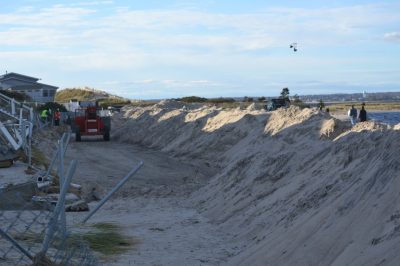Beach nourishment is defined as the artificial addition of sand, gravel or other similar natural material to a beach or subtidal area adjacent to a beach. This activity may require a permit from regulated DEEP OLISP pursuant to the Structures, Dredging and Fill Act (Conn. Gen. Statutes (CGS) Sec. 22a-359 – 22a-363f, inclusive). It is important to work with both a coastal engineer and DEEP OLISP permitting staff before developing a beach nourishment plan.
Beach nourishment can be an effective, temporary response to coastal erosion, though it tends to be costly, and its effectiveness is generally short-lived (5 years or less), especially in areas with high erosion rates. Generally, there are two sources of material in Connecticut that have been used for beach nourishment:
- “beneficial reuse” of dredged material, usually in conjunction with a federal (US Army Corps of Engineers) dredging project of navigable waterways; and
- upland sourcing of material, typically from a gravel pit, where trucks are used to transport material from an upland source to the beach.

Generally, if the U.S. Army Corps of Engineers dredges a project and the material is considered to be clean, beach-compatible sand, the beneficial reuse of dredged materials as beach nourishment is encouraged. If beach nourishment is considered to be a least cost alternative for disposal of the dredged material, the costs of dredging and material placement are borne by the federal government. If not, some cost-matching by a local sponsor (typically the receiving community) is required for the Corps to proceed with a project.